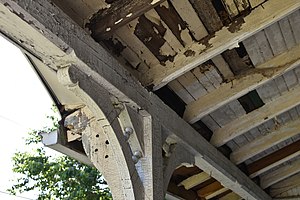
Lead-based paint was widely used in the United States because of its durability. The United States banned the manufacture of lead-based house paint in 1978 due to health concerns.
Lead has long been considered to be a harmful environmental pollutant. Cited cases of lead poisoning date back to the early 20th century.[1] In the July 1904 edition of its monthly publication, paint manufacturer, Sherwin-Williams, reported the dangers of paint containing lead, noting that a French expert had deemed lead paint "poisonous in a large degree, both for the workmen and for the inhabitants of a house painted with lead colors."[2]
In 1971, Congress banned the use of lead-based paint in residential projects (including residential structures and environments) constructed by, or with the assistance of, the federal government.[3] The Consumer Product Safety Commission followed with implementing regulations, effective in 1978.[4] Additional regulations regarding lead abatement, testing and related issues have been issued by the Environmental Protection Agency (EPA).
Much of the government's response to the lead public health problems in the 1970s can be credited to the work of epidemiologist and pediatrician, Philip J. Landrigan, who conducted detailed studies of lead poisoning near lead refineries, as well as the effects of lead in gasoline.[5]
In 1991, Secretary of the Department of Health and Human Services, Louis Wade Sullivan, called lead the "number one environmental threat to the health of children in the United States." Humans are exposed to lead through air, drinking water, food, contaminated soil, deteriorating paint, and dust.[6][7] Airborne lead enters the body by breathing or swallowing lead particles or dust once it has settled. Old lead-based paint is the most significant source of lead exposure in the U.S.[7][8] Most homes built before 1960 contain heavily leaded paint. Some homes built as recently as 1978 may also contain lead paint.[citation needed]
The U.S. Centers for Disease Control and Prevention’s (CDC) National Center for Health Statistics monitors blood lead levels in the United States.[6] Experts use a new level based on the U.S. population of children ages 1-5 years who are in the top 2.5% of children when tested for lead in their blood (when compared to children who are exposed to more lead than most children). Currently that is 3.5 micrograms of lead per deciliter of blood.[6]
- ^ Lah, Katarina (2011-05-08). "History of Lead Use". Toxipedia. Seattle, WA: Institute of Neurotoxicology & Neurological Disorders.
- ^ Guenther, Richard (1904-02-24). "Dangers of White Lead". Hathitrust. Sherwin Williams Co. Retrieved 2014-10-31.
- ^ United States. Lead-Based Paint Poisoning Prevention Act. Pub. L. 91–695. Approved 1971-01-13.
- ^ U.S. Consumer Product Safety Commission, Washington, D.C. "Lead-Containing Paint and Certain Consumer Products Bearing Lead-Containing Paint." Federal Register, 42 FR 44199, 1977-09-01. 16 CFR 1303. Bans residential lead-based paint manufactured after February 27, 1978.
- ^ "How Much Do Chemicals Affect Our Health? Philip Landrigan tracks how dangers like the WTC can cause problems like ADD". Discover. Kalmbach Publishing. May 2008.
- ^ a b c "Learn about Lead". EPA. 2013-04-01.
- ^ a b "Lead-Based Paint - Remodeling Your Home?". US Environmental Protection Agency (EPA). Retrieved 2013-04-22.
- ^ "About Lead-based Paint". Washington, D.C.: US Department of Housing and Urban Development (HUD). Archived from the original on 2013-04-19. Retrieved 2013-04-22.